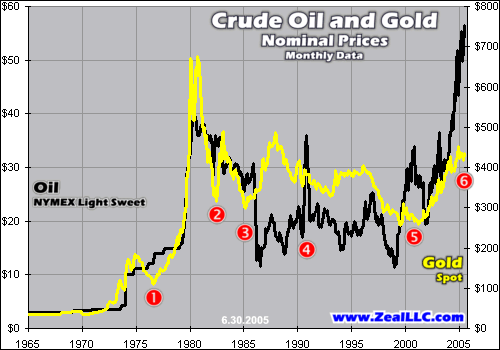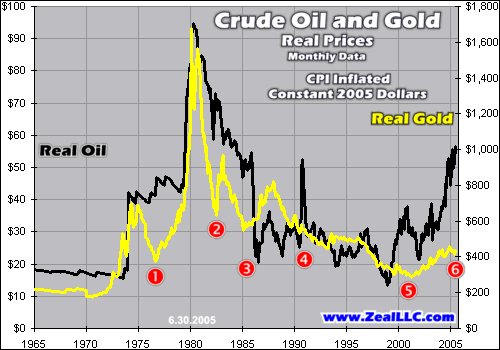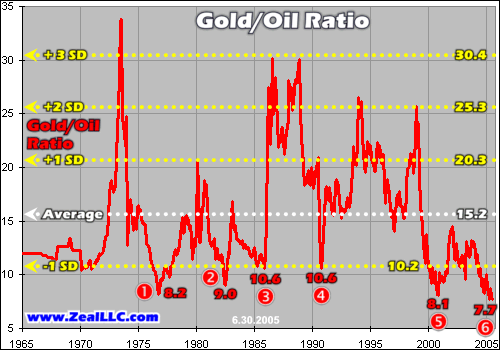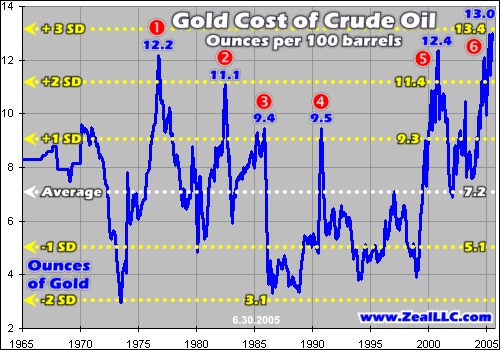
Dawson City
(L’utilisation potentielle de l’or comme monnaie d’échange par l’industrie pétrolière)
[Note: Prepared remarks by RHH for Gold Rush 21, The GATA Gold Conference, August 8-9, 2005, Dawson City, Yukon, Canada]
Good Morning. Bonjour. The Gold Anti-Trust Action Committee is holding this conference to ask a simple question with a far from simple answer: Where does GATA go from here?
Having just arrived in Dawson City by motorcycle from Boston through Montreal and across Canada, I’m tempted to suggest “south,” which not incidentally is the long-term direction of the U.S. dollar and the rest of the world’s paper currencies.
My long ride to the epicenter of the Klondike gold rush has given me a new appreciation of the hardships encountered by the early prospectors who opened Canada’s north largely by canoe and portage in their lonely searches for free gold. See Arnold Hoffman, Free Gold: The Story of Canadian Mining (McGraw-Hill, 1982; originally published 1947). About the only certainties in their lives were that failure to get out before the winter freeze meant death and that gold, if they found it, was real money and not credit. Our daily lives are far more comfortable, but few of us can say or agree on what — if anything — is now money but not credit.
For over six years, GATA has labored online and off to expose the manipulation of gold prices by a cabal of powerful governments, central banks and bullion banks. The evidence it has assembled leaves little doubt that for over a decade the allegedly “free” post-Bretton Woods gold market has been rigged, largely through the use of derivatives supported by central bank lending, with the goal of making paper currencies — especially the U.S. dollar — look stronger than they are and keeping worldwide interest rates lower than they should be.
In postings at our website, The Golden Sextant, Bob Landis and I have reviewed much of this evidence, especially as it relates to gold lending in one form or another by central banks and to gold derivatives on the books of the bullion banks. Indeed, my most recent commentary, Gold Derivatives: Skewing the World (6/15/2005), addressed this very subject based on the most recent data from the Bank for International Settlements.
Today, as suggested in the title of my talk, I propose to offer some new ideas on how to free the gold market from the iron grip of the banks.
Puisque nous sommes au Canada, permettez-moi d’employer également un titre en français: « L’utilisation potentielle de l’or comme monnaie d’échange par l’industrie pétrolière » . Et comme cette affirmation résume en fait l’essence de ma présentation, je vais continuer en anglais.
Pimps and Wimps. Among government officials, bankers and economists, gold has become a four-letter word often used with “bug” to convey the idea that advocates of sound money are a pest, not to mention a mortal threat to the modern democratic (small “d”) welfare state, which cannot function on permanent natural money of gold or silver.
As Alan Greenspan himself once observed: “[T]he gold standard in any form … is incompatible with chronic deficit spending — the hallmark of the welfare state.” A. Greenspan, Gold and Economic Freedom (1966, reprinted in A. Rand, Capitalism: The Unknown Ideal. You can’t forever buy people’s votes with their children’s money except on a regime of unlimited government-issued legal tender paper.
Bankers — especially if they are politically well-connected — welcome this type of monetary regime because the risks of fractional reserve banking and major failures due to poor banking practices are more easily mitigated by the central bank in its role as lender of last resort. No profit-minded banker will go for gold when it’s much easier and more lucrative to get in bed with the Fed.
Like Lord Keynes, most modern economists consider the classical gold standard a “barbarous relic.” A couple of years after President Nixon closed the gold window in 1971, one economist put the problem like this (Janos Fekete, president of the Hungarian National Bank, as quoted by M. Mayer, The Fate of the Dollar (Truman Talley, 1980), p. 61):
There are about three hundred economists in the world who are against gold, and they think that gold is a barbarous relic — and they might be right. Unfortunately, there are three billion inhabitants of the world who believe in gold. Now the problem is how can we three hundred convince the other three billion of the correctness of our ideas. I think we could if we had time. But we need a lot of time.
Since the days of the New Deal, American colleges and universities have spread the anti-gold message, laying much of the blame for the Great Depression on the discipline of the gold standard itself. American law schools long ago eliminated any serious discussion of the monetary principles of the Constitution. Conservative legal scholars who focus on the original intent of its framers pay no intention to their shared monetary views, which were shaped in large measure by the collapse of the Continental currency.
Notwithstanding more than 70 years of pervasive anti-gold propaganda, the paper money crowd has never mustered the confidence to propose amending the Constitution to authorize what we have and have had since 1971: a central bank with the power to issue unlimited fiat money. See Fork in the Road: Appeal of Right or Right Appeal (6/18/2002); Money in Court: Paving the Road to Ruin (6/1/2002).
Surprisingly, among the earliest converts to the notion that gold should no longer be regarded as money was the gold mining industry itself. Largely decimated by the flawed Bretton Woods system, the industry has through the World Gold Council run an expensive campaign to promote the use of gold as jewelry while distancing itself from any advocacy of gold as money. Admittedly, gold producers need mining permits from governments and financing from banks, so their conversion may not have been wholly voluntary. But whatever the reason, most of these golden geese behave more like ostriches.
Since its inception, GATA has approached a large number of government officials, bankers, economists (both mainstream and free market) and senior managers in the gold industry for assistance in fighting price fixing in the gold market. With distressingly few exceptions, these worthies have proven pimps for political power or wimps in fear of it. To secure free markets in the monetary metals and to reestablish sound money of gold or silver, GATA must look elsewhere for help.
Black Gold. Ferdinand Lips, a stalwart friend of GATA and author of Gold Wars: The Battle Against Sound Money As Seen from a Swiss Perspective (FAME, 2001), recently gave a lecture in Saudi Arabia to the Gulf Research Council on the topic: “Oil for gold or oil for paper?” Noting that the world is “in the midst of a global currency devaluation scenario,” he observed that “while oil is the king of commodities, gold is the king of money,” and he suggested that oil producers are not getting real value by pegging its price to the dollar. See P.V. Vivekanand, GCC Urged to Peg its Currency to Gold, www.arabnews.com (May 29, 2005).
While oil has lost none of its importance in the real world, the energy sector as a percent of the S&P 500 declined from around 25% in 1980 to just over 7% at the beginning of this year. Over the same period, the financial services sector grew from just over 5% to almost 23%. See S&P 500 Sector Weightings at www.Barra.com.
Adam Hamilton, proprietor of ZealLLC and a regular contributor to The Metropole Cafe, has written extensively on the gold/oil ratio. See, e.g., A. Hamilton, Gold/Oil Ratio Extremes 2 (April 1, 2005). At my request and for this conference, Adam has provided two sets of charts updated through June 30, 2005.
The first set compares oil and gold prices — nominal and real — against each other, and shows the remarkably close correlation of their long-term price trends over the past 40 years.


Within these closely correlated in long-term trends, however, there have been wide swings in relative prices. These are captured in the gold/oil ratio, which is shown in the second set of charts, first as the number of barrels of oil equating in value to one ounce of gold, and second as the cost in ounces of gold of 100 barrels of oil. At the end of June, gold had never been cheaper relative to oil or oil more expensive relative to gold.


As these charts show, oil prices have far out paced gold over the past decade. This phenomenon is wholly consistent with the official suppression of gold prices during the same period. And it is underscored by the enormous differences in the market capitalizations of the eight largest gold companies versus the eight largest integrated oils covered by Value Line.
Market Capitalization (Mid-Year 2005) (US$ billions) Newmont 17.4 Exxon Mobil 371 Barrick 13.5 BP 227 AngloGold Ashanti 9.5 Royal Dutch/Shell 232 Placer Dome 6.7 Total 140 Goldfields 5.6 Chevron 120 Goldcorp 3.0 ConocoPhillips 82 Buenaventura 2.9 Petrobras 58 Harmony 2.8 Repsol-YPF 31
Coin of the Realm. Swings in the gold/oil ratio may not be of much use to short-term traders, but they provide opportunities for patient, long-term investors, especially if they are well-financed and can afford to wait for the principle of reversion to the mean to assert itself. No one is better positioned nor should have greater incentive to play the gold/oil ratio than the oil companies themselves.
Indeed, by integrating the gold/oil ratio into their financial strategies, oil producers could achieve indirectly — and possibly more effectively — many of the benefits of pricing oil in gold, but without incurring some of the risks and much of the political fallout that any move away from pricing in U.S. dollars would entail.
The following table provides some background figures on the debt and share repurchase programs of the eight major integrated international oil companies listed in the prior table. The first five carry Value Line’s highest rating (A++) for financial strength.
Additional Data on Oil Companies
(from Value Line and annual reports; US$ billions)
| Debt | Share Repurchase | ||
| Total | Long-Term | Program | |
| Exxon Mobil | 8.3 | 5.0 | ongoing; $10 bil. in 2004 |
| BP | 19.6 | 12.2 | ongoing; $7.5 bil. in 2004 |
| Royal Dutch/Shell | 13.7 | 8.0 | $3-5 bil. planned for 2005-6 |
| Total | 26.5 | 13.9 | ongoing; “vigorous” |
| Chevron | 10.8 | 10.2 | ongoing |
| ConocoPhillips | 14.0 | 13.9 | |
| Petrobras | 14.0 | 12.0 | |
| Repsol-YPF | 15.2 | 9.7 | |
Gold Equivalents
(metric tonnes at US$420/ounce in US$ billions)
| 100 | 1.35 | |
| 500 | 6.75 | (annual gold sales permitted under CBAG) |
| 1000 | 13.5 | |
| 2500 | 33.8 | (approx. annual new mine production) |
| 3000 | 40.5 | (approx. gold reserves of the IMF) |
| 8000 | 108.0 | (approx. gold reserves of the U.S.) |
| 30,000 | 405.1 | (approx. total official gold reserves) |
100 1.35 500 6.75 (annual gold sales permitted under CBAG) 1000 13.5 2500 33.8 (approx. annual new mine production) 3000 40.5 (approx. gold reserves of the IMF) 8000 108.0 (approx. gold reserves of the U.S.) 30,000 405.1 (approx. total official gold reserves)
These figures suggest several questions applicable not only to these large integrated oil companies but also to smaller oil producers with significant cash resources:
Does it make financial sense for oil producers to engage in large share repurchases when oil is historically expensive relative to gold?
Following the same policy as the International Monetary Fund, could oil producers add further strength to their balance sheets by holding gold reserves, particularly if purchased at favorable prices relative to oil?
If oil producers held gold reserves, could they employ them to lower the effective rate of interest on their long-term debt by issuing gold-backed or gold-redeemable securities?
Should oil producers consider investments in, or acquisitions of, gold producers?
Time does not permit an extensive discussion of these questions. Arguments can be made on both sides of each. But if only a handful of oil producers, or just one of the large integrated oil companies, began to invest seriously in gold bullion or the gold mining industry, it would be a watershed event.
Almost overnight the gold market would cease to be the almost exclusive preserve of the central banks and their allies in the bullion banks. What is more, the first oil producers to move into the gold or gold share markets would stand to reap the greatest rewards since their own purchases would almost certainly propel prices higher in these relatively small markets.
Pride of Nations. Oil, of course, involves politics as much as it does economics and finance. Not only is oil essential to the functioning of modern industrial economies, but also no other commodity arouses as strong feelings of nationalism, especially in countries having significant reserves. Like gold, oil is where you find it, making its producers citizens of the world who must be sensitive to the demands and aspirations of the nations in which they operate.
Mayer Amschel Rothschild (1744-1812), founder of the banking dynasty that bears his name and a contemporary of the framers of the American Constitution, famously observed: “Give me control of a nation’s money and I care not who makes her laws.” This statement expresses the essence of the political argument for money of gold or silver, and for insulating money as much as possible from manipulation by the banks.
Particularly in the post-Bretton Woods world, the practice of pricing oil in U.S. dollars gives every appearance of having been “Made in America” by the U.S. Treasury and Federal Reserve for the benefit of Americans. Without question it provides important support for the dollar. Indeed, some argue that Saddam signed his own death warrant, or at least that of his regime, by changing the pricing of Iraq’s oil from dollars to euros.
But pricing oil in euros carries many of the same dangers as pricing it in dollars. The results of the recent referendums in France and the Netherlands on closer European political integration, not to mention polls in Germany suggesting wide support for the return of the Deutschemark, have rekindled doubts about the long-term viability of the euro itself. Some have even suggested the possibility that France and Germany might create a “new euro” in combination with the oil-rich Russians, thus making the new unit an important petrocurrency as well as endowing it with the historic German commitment to sound money and the French affinity for gold.
Oil, money and nationalism are an explosive combination, and one that is likely to play a growing role in world affairs over the coming years. It is a future for which the oil companies should prepare, and one for which they will be better positioned if they have already started to edge away from the dollar or the euro toward gold.
Copyright – Reginald H. Howe – 2005
